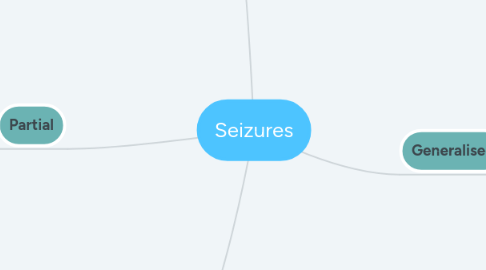
1. Partial
1.1. Simple Focal/Partial
1.1.1. Temporal Lobe
1.1.1.1. Deja Vu with smell or taste
1.1.1.2. Sudden and intense feeling of fear or joy
1.1.2. Frontal Lobe
1.1.2.1. Stiffness or twitching I part of the body such as the arm or hand
1.1.3. Parietal Lobe
1.1.3.1. Feeling of numbness or tingling
1.1.4. Occipital Lobe
1.1.4.1. Visual disterbances
1.1.4.2. Hallucinations
1.2. Complex Focal/Partial
1.2.1. Usually last 15-30 seconds
1.2.2. Usually effects the temporal lobe
1.2.3. May show repetitive movements such as: Fiddling with clothing, chewing or lip smacking, walking round in a confused way
1.2.4. Loss of consciousness may occur
2. Status Epilepticus
2.1. Convulsions lasting longer than 30 minutes
2.2. Repeated seizures for over 30 minutes with no recovery in between
2.3. Can be life threatening
3. Secondary Generalised
3.1. Begins as a focal seizure but spreads into the other hemisphere and becomes generalised
4. Generalised
4.1. Absences (AKA a Petit Mal)
4.1.1. More common in children than in adults
4.1.2. Can be frequent
4.1.3. Usually only last a few seconds
4.1.4. Usually remain conscious with a reduced awareness of surroundings
4.1.5. Eyelid flickering
4.2. Myoclonic
4.2.1. Muscle jerking
4.2.2. Often has other generalised forms of epilepsy
4.2.3. Remains conscious
4.2.4. Often occur in clusters but are relatively short lived
4.3. Tonic clonic
4.3.1. Unconscious
4.3.2. May cry out
4.3.3. Body goes stiff and they usually fall backwards (Tonic)
4.3.4. May bite their tongue or cheek
4.3.5. They jerk and shake (convulse) as their muscles relax and tighten rhythmically
4.3.6. Breathing might be affected and become difficult or sound noisy
4.3.7. Pallor or cyanosis
4.3.8. Incontinence
4.3.9. After the seizure, breathing and colour return to normal and they may feel tired, confused, have a headache or want to sleep (Post Ictal)
4.4. Tonic
4.4.1. Become rigid and fall over
4.4.2. Usually brief and occur without warning
4.4.3. Injuries are common
4.5. Clonic
4.5.1. Similar to Tonic clonic seizures but the patient does not go rigid at the start
4.6. Atonic/ Drop Attack
4.6.1. Complete and sudden loss of muscle tone
4.6.2. Last a few seconds
4.6.3. Relatively quick recovery
4.6.4. May result in injuries

